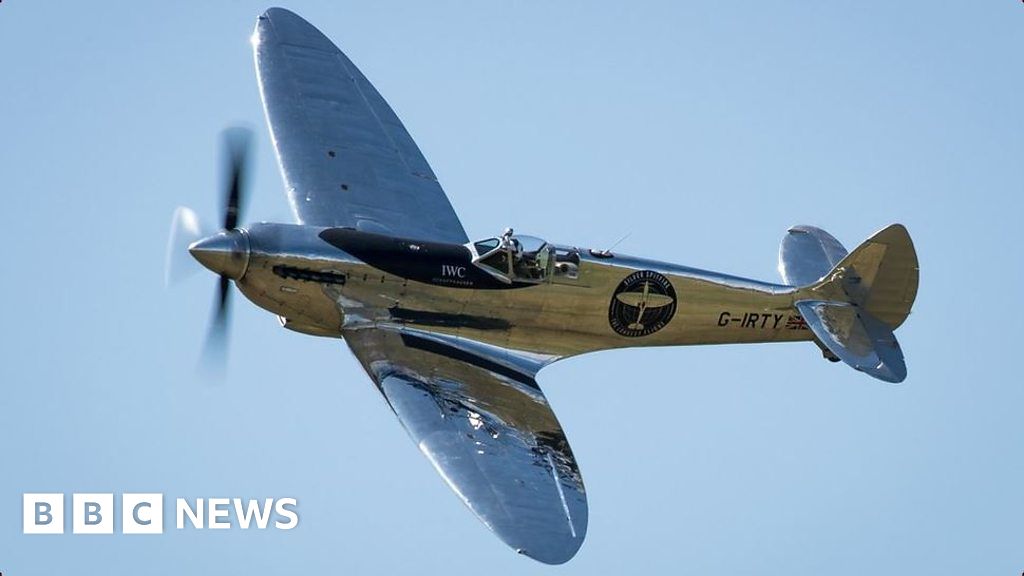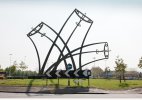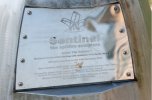I have more of a Huricane being reconstructed for flight and Motion with sound but the latter will not post for some reason...maybe too large. Anyway time for my flight home...hand crank undercarriage with curved rear elevator. Five hour flight.
-
Welcome to this forum . We are a worldwide group with a common interest in Birmingham and its history. While here, please follow a few simple rules. We ask that you respect other members, thank those who have helped you and please keep your contributions on-topic with the thread.
We do hope you enjoy your visit. BHF Admin Team
You are using an out of date browser. It may not display this or other websites correctly.
You should upgrade or use an alternative browser.
You should upgrade or use an alternative browser.
Would anyone have a picture of the Smethwick Spitfire they could share with me please? I am writing an article for our local heritage centre and would like to include a photo of the Smethwick Spitfire if possible. There was one on page 7 of this thread but is not available now.
Any help would be greatly appreciated.
Any help would be greatly appreciated.
jill allman
New Member
Does anyone know what happened at Vickers Castle Bromwich on August 13th 1940? My uncle was given a certificate for "gallant conduct and distinguished services" for what ever occurred. Presumably an air raid but any info would be appreciated.
Welcome Jill.
According to Wikipedia
"There had been a fatal bombing at the factory on 13 August 1940, in which six workers were killed."
And there's a diary of a local boy, Brian Williams, here in which the raid is mentioned
https://brianwilliams.org.uk/diary/1940.html
The factory was a key enemy target. Raids were frequent in the vicinity. Shall see if I can find further details. Viv.
According to Wikipedia
"There had been a fatal bombing at the factory on 13 August 1940, in which six workers were killed."
And there's a diary of a local boy, Brian Williams, here in which the raid is mentioned
https://brianwilliams.org.uk/diary/1940.html
The factory was a key enemy target. Raids were frequent in the vicinity. Shall see if I can find further details. Viv.
oldMohawk
gone but not forgotten
As Viv stated ...
The Spitfire Factory at Castle Bromwich was bombed on the night of 13th August 1940 and six people were killed.
Their names are listed on the https://database.birminghamairraids.co.uk/
You may have to type Castle Bromwich in the 'By location of death' field depending on how it appears on your device.
The Spitfire Factory at Castle Bromwich was bombed on the night of 13th August 1940 and six people were killed.
Their names are listed on the https://database.birminghamairraids.co.uk/
You may have to type Castle Bromwich in the 'By location of death' field depending on how it appears on your device.
Last edited:
jill allman
New Member
What speedy service! Yes please, any information would be helpful. My Uncle worked there and the story goes when he got bombed out of a job he enlisted! After he had finished in Africa he went to Australia to live, so never got to know him. His children are asking me what the certificate is for.
Jill
Jill
oldMohawk
gone but not forgotten
Hi Jill, why not upload an image of the certificate here because there are forum members who might be able to find out information about it.
Many photos of the factory can be seen here https://spitfiresite.com/2012/07/castle-bromwich-spitfire-and-lancaster-factory-photos.html
oldmohawk
Many photos of the factory can be seen here https://spitfiresite.com/2012/07/castle-bromwich-spitfire-and-lancaster-factory-photos.html
oldmohawk
jill allman
New Member
Have had a look on the website. Sounds like a night (of many) never to forget! Thanks for the info.As Viv stated ...
The Spitfire Factory at Castle Bromwich was bombed on the night of 13th August 1940 and six people were killed.
Their names are listed on the https://secure.swanshurst.org/barra/results.asp
You may have to type Castle Bromwich in the 'By location of death' field depending on how it appears on your device.
jill allman
New Member
Will give that a go but now supper is requested!Hi Jill, why not upload an image of the certificate here because there are forum members who might be able to find out information about it.
Many photos of the factory can be seen here https://spitfiresite.com/2012/07/castle-bromwich-spitfire-and-lancaster-factory-photos.html
oldmohawk
oldMohawk
gone but not forgotten
An account from Megan Rees (age 19 at the time) who worked on Spitfires at the Castle Bromwich Aircraft Factory is worth a read on https://www.bbc.co.uk/history/ww2peopleswar/stories/82/a4093382.shtml
The quotation below from her account mentions the aftermath of a serious bombing raid on D block.
The quotation below from her account mentions the aftermath of a serious bombing raid on D block.
I remember going to work to start the 6am shift one morning and D Block had been bombed the night before. The clothes, shoes and gas masks of the workers from D Block were piled in heaps between A and C Blocks. They were wet from the water used by the fire brigade to fight the fires. You could see bodies still in the girders of the roof of the factory. It is a sight that you never forget. It was after the bombing of D Block that they altered the working hours to three shifts, 6am to 2pm, 2pm to 10pm and 10pm to 6am.
There were air raids during the day too. The German planes would machine gun the workers running to the shelters. Another time when there was bombing during the day, my mother sent my brother Jack (he was not working because he was ill with TB) to the factory to see if I was okay. While making his way to the factory he had to shelter under a bridge because the German planes were machine-gunning the roads.
Pedrocut
Master Barmmie
Crashed WW2 Spitfire flies again after £3m refit
https://www.bbc.co.uk/news/uk-england-cambridgeshire-39220403
https://www.bbc.co.uk/news/uk-england-cambridgeshire-39220403
S
Stitcher
Guest
Pedrocut
Master Barmmie
WW2 Spitfire pilot Joy Lofthouse dies aged 94.
https://www.bbc.co.uk/news/uk-england-gloucestershire-42012740
https://www.bbc.co.uk/news/uk-england-gloucestershire-42012740
Pedrocut
Master Barmmie
WW2 Spitfire pilot Mary Ellis dies.
https://www.bbc.co.uk/news/uk-44962253
https://www.bbc.co.uk/news/uk-44962253
Contrary to what books and TV documentaries say, I believe the Merlin engine used in Spitfires was not designed by Henry Royce with his mythical "walking-stick in the sand", but by Arthur Rowledge MBE, FRS, FRAS., who was Royce's Chief Assistant from 1921.
Rowledge worked for Napier before joining Wolseley at Adderley Park in Birmingham in 1905 (living in Dora Road, Small Heath), where he designed an advanced, innovative, V8 hydroplane engine and was instrumental in helping to design Wolseley sleeve valve motor car engines under development in 1913.
Rowledge returned to Napier in 1913 as Chief Designer, and designed the record breaking Napier Lion aero engine, but left that company in 1921 to join Rolls-Royce as Chief Assistant to Henry Royce.
His first task at Rolls-Royce was to redesign all their dated aero engines and he later designed and developed the racing aero engines for the Supermarine aircraft which won the Schneider Trophy races in 1929 and 1931.
Unfortunately, Rowledge has never received the recognition he so richly deserves.
Boomy.
Rowledge worked for Napier before joining Wolseley at Adderley Park in Birmingham in 1905 (living in Dora Road, Small Heath), where he designed an advanced, innovative, V8 hydroplane engine and was instrumental in helping to design Wolseley sleeve valve motor car engines under development in 1913.
Rowledge returned to Napier in 1913 as Chief Designer, and designed the record breaking Napier Lion aero engine, but left that company in 1921 to join Rolls-Royce as Chief Assistant to Henry Royce.
His first task at Rolls-Royce was to redesign all their dated aero engines and he later designed and developed the racing aero engines for the Supermarine aircraft which won the Schneider Trophy races in 1929 and 1931.
Unfortunately, Rowledge has never received the recognition he so richly deserves.
Boomy.
Pedrocut
Master Barmmie
Spitfire pilots return to Goodwood after round-the-world trip.

 www.bbc.co.uk
www.bbc.co.uk

Restored Spitfire pilots return from record trip
Steve Brooks and Matt Jones return back to Britain after a record 27,000-mile flight around the world.
This looks like a fascinating site, well worth a look:
Castle Bromwich Spitfire and Lancaster Factory in Pictures
Castle Bromwich Spitfire and Lancaster Factory in Pictures
Lloyd
master brummie
I agree, for modern art it's very good. Sadly there are some others I would not classify so kindly.Spitfire Fire island Castle Brom (Tim Tolkien), I love the sculpture it’s a living piece of art and represents Birminghams industry in WW2
Covroad
master brummie
There is an element of geographical ‘snobbery’ in the country regarding art especially industrial art as I class it. Anything from London is art immediately, yet regionally art is often critiqued or discounted by the so called elitists.I agree, for modern art it's very good. Sadly there are some others I would not classify so kindly.
My personal favourites of industrial art are , The Sleeping Giant (Bluenose) , Spitfire Island, Pump Island, and the Golden Boys .





